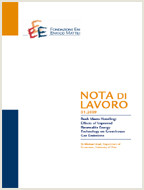Investing in Photovoltaics: Timing, Plant Sizing and Smart Grids Flexibility

01.09.2016
Marina Bertolini (University of Padova, Centro Studi “Giorgio Levi Cases”); Chiara D’Alpaos (University of Padova, Centro Studi “Giorgio Levi Cases”); Michele Moretto (University of Padova, Fondazione Eni Enrico Mattei, Centro Studi “Giorgio Levi Cases”)
Q42, C61, D81
Smart Grids, Renewable Energy Sources, Real Options, Prosumer
Mitigation, Innovation and Transformation Pathways
Massimo Tavoni
In Italy and in many EU countries, the last decade was characterized by a large development of distributed generation power plants. Their presence determined new critical issues for the design and management of the overall energy system and the electric grid due to the presence of discontinuous production sources. It is commonly agreed that contingent problems that affect local grids (e.g. inefficiency, congestion rents, power outages, etc.) may be solved by the implementation of a “smarter” electric grid. The main feature of smarts grid is the great increase in production and consumption flexibility. Smart grids give producers and consumers, the opportunity to be active in the market and strategically decide their optimal production/consumption scheme. The paper provides a theoretical framework to model the prosumer’s decision to invest in a photovoltaic power plant, assuming it is integrated in a smart grid. To capture the value of managerial flexibility, a real option approach is implemented. We calibrate and test the model by using data from the Italian energy market.
***
Suggested citation: Bertolini, M., C. D’Alpaos, M. Moretto, (2016), ‘Investing in Photovoltaics: Timing, Plant Sizing and Smart Grids Flexibility’, Nota di Lavoro 60.2016, Milan, Italy: Fondazione Eni Enrico Mattei
